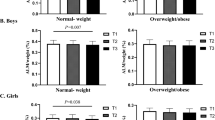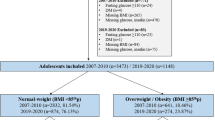Abstract
Objective: To examine the relationships between TNF-α, obesity, and insulin resistance among prepubescent children.
Design: Cross-sectional study.
Setting and subjects: Data were collected from 112 nondiabetic Latino schoolchildren from public schools in three South Florida communities. Of the enrolled participants, 43.8% were obese (BMI 95th percentile) and 51.8% presented with a family history of type 2 diabetes mellitus (T2DM). With one exception, all demonstrated normal glucose tolerance.
Interventions: Plasma TNF-α levels were determined with enzyme-linked immunosorbance assay (ELISA). Homeostasis model assessment (HOMA-IR) was calculated as an index of insulin resistance. Mean levels of TNF-α among obese vs nonobese children were compared with a one-way analysis of variance with two groups, and the association between TNF-α and HOMA-IR was assessed with a Pearson's correlation.
Results: Higher circulating TNF-α levels were revealed among nonobese vs obese children. Nonobese girls demonstrated higher TNF-α levels than obese girls, whereas there were no significant differences for boys. There were no significant differences after stratifying for family history of T2DM. There was a modest relationship between increased TNF-α levels and decreased insulin resistance.
Conclusions: The observed elevated circulating TNF-α concentrations among leaner participants may reflect an inflammatory process that has been associated with higher levels of physical fitness in both adults and prepubescent children. This effect may remain stronger for prepubescent girls, and the mechanism may be attenuated by the hormonal changes that occur with the onset of puberty.
Sponsorship: This research was supported, in part, by a clinical research grant from the American Diabetes Association, as well as NIMH NRSA # 5T32 MH18917-09.
This is a preview of subscription content, access via your institution
Access options
Subscribe to this journal
Receive 12 print issues and online access
$259.00 per year
only $21.58 per issue
Buy this article
- Purchase on Springer Link
- Instant access to full article PDF
Prices may be subject to local taxes which are calculated during checkout

Similar content being viewed by others
References
Bazzoni F & Buetler B (1996): The tumor necrosis factor ligand and receptor families. N. Engl. J. Med. 334, 1717–1725.
Bonora E, Targher G, Alberiche M, Bonadonna RC, Saggiani F, Zenere MB, Monauni T & Muggeo M (2000): Homeostasis model assessment closely mirrors the glucose clamp technique in the assessment of insulin sensitivity. Diabetes Care 23, 57–63.
Chu N-F, Shen M-H et al. (2002): Plasma TNF-R1 and insulin concentrations in relation to leptin levels among normal and overweight children. Clin. Biochem. 35, 287–292.
Delamater A, Brito A et al. (2001): Obesity and family history increase metabolic risk in Hispanic children. Ann. Behav. Med. 23 (Suppl), S130.
DiMartino-Nardi J (1999): Premature adrenarche: findings in prepubertal African-American and Caribbean-Hispanic girls. Acta Paediatrica 433 (Suppl), 67–72.
Goran MI (2001): Metabolic precursors and effects of obesity in children: a decade of progress, 1990–1999. Am. J. Clin. Nutr. 73, 158–171.
Grumbach MM & Styne DM (1998): Puberty: ontogeny, neuroendocrinology, physiology, and disorders. In Williams Textbook of Endocrinology, eds Wilson JD, Foster DW, Kronenberg HM & Larsen PR, pp 1509–1625. Philadelphia, PA: Saunders.
Hammer LD, Kraemer HC et al. (1991). Standardized percentile curves of body-mass index for children and adolescents. Am J Dis Child 145, 259–263.
Hotamisligil GS, Arner P et al. (1995): Increased adipose tissue expression of tumor necrosis factor-[alpha] in human obesity and insulin resistance. J. Clin. Invest. 95, 2409–2415.
Kern PA, Saghizadeh M et al. (1995): The expression of tumor necrosis factor in human adipose tissue: regulation by obesity, weight loss, and relationship to lipoprotein lipase. J. Clin. Invest. 95, 2111–2119.
Ludwig DS, Peterson KE et al. (2001): Relation between consumption of sugar-sweetened drinks and childhood obesity: a prospective, observational analysis. Lancet 357, 505–508.
Mitchell BD, Valdez R et al. (1993): Differences in the prevalence of diabetes and impaired glucose tolerance according to maternal or paternal history of diabetes. Diabetes Care 16, 1262–1267.
Nemet D, Oh Y et al. (2002): Effect of intense exercise on inflammatory cytokines and growth mediators in adolescent boys. Pediatrics 110, 681–689.
Nemet D, Wang P et al. (2003): Adipocytokines, body composition, and fitness in children. Pediatric Res. 53, 148–152.
Owens DR, Wragg KG et al. (1979): Comparison of the metabolic response to a glucose tolerance test and a standardized test meal and the response to serial test meals in normal healthy subjects. Diabetes Care 2, 409–413.
Peraldi P, Xu M et al. (1997): Thiazolidinediones block tumor necrosis factor-alpha-induced inhibition of insulin signaling. J. Clin. Investig. 100, 1863–1869.
Pfeiffer A, Janott J et al. (1997): Circulating tumor necrosis factor [alpha] is elevated in male but not in female patients with type II diabetes mellitus. Hormone Metab. Res. 29, 111–114.
Prins JB, Niesler CU et al. (1997): Tumor necrosis factor-[alpha] induces apoptosis of human adipose cells. Diabetes 46, 1939–1944.
Scheett TP, Milles PJ et al. (1999): Effect of exercise on cytokines and growth mediators in prepubertal children. Pediatric Res. 46, 429–434.
Skolnik E & Marcusohn J (1996): Inhibition of insulin receptor signaling by TNF: potential role in obesity and non-insulin-dependent diabetes mellitus. Cytokine Growth Factor Rev. 7, 161–173.
Uysal K, Wiesbrock S et al. (1997). Protection from obesity-induced insulin resistnace in mice lacking TNF-alpha function. Nature 389, 610–614.
Winkler G, Lakatos P et al. (1999): Elevated serum TNF-alpha level as a link between endothelial dysfunction and insulin resistance in normotensive obese patients. Diabetes Med. 16, 207–211.
Acknowledgements
This study was funded in part by a National Research Service Award (NRSA) from the National Institutes of Health (NIH). Dr Denise Dixon held an NIH NRSA postdoctoral fellowship with the University of Miami (#5T32 MH18917-09). We acknowledge Ms Espi Perez, RN, who assisted with the data collection phase of the study.
Author information
Authors and Affiliations
Contributions
Guarantor: D Dixon.
Contributors: DD designed the component of the study related to the TNF findings, performed all of the cytokine assays and statistical analyses, interpreted the data, and wrote the manuscript. RG and AD were the primary investigators and designed the main study, obtained funding and ethical approval, supervised the running of the study, managed the data collection, contributed to the writing, and provided final approval of the manuscript. AD supervised the data entry and cleaning. AD, RG, and NS contributed to the interpretation of the data. NS obtained funding for the cytokine assays and contributed to the final approval of the manuscript.
Corresponding author
Rights and permissions
About this article
Cite this article
Dixon, D., Goldberg, R., Schneiderman, N. et al. Gender differences in TNF-α levels among obese vs nonobese Latino children. Eur J Clin Nutr 58, 696–699 (2004). https://doi.org/10.1038/sj.ejcn.1601852
Received:
Revised:
Accepted:
Published:
Issue Date:
DOI: https://doi.org/10.1038/sj.ejcn.1601852
Keywords
This article is cited by
-
Circulating microRNAs 34a, 122, and 192 are linked to obesity-associated inflammation and metabolic disease in pediatric patients
International Journal of Obesity (2021)
-
Cardiovascular disease in childhood: the role of obesity
European Journal of Pediatrics (2013)
-
Do Obese Children Have Chronic Inflammation & Could This Contribute to Future CVD Risk?
Current Cardiovascular Risk Reports (2012)
-
Inflammatory mediators in overweight and obese Spanish adolescents. The AVENA Study
International Journal of Obesity (2004)



